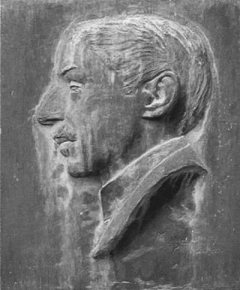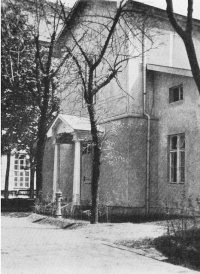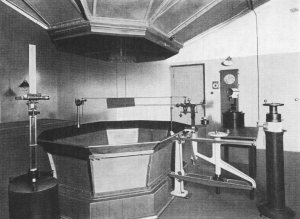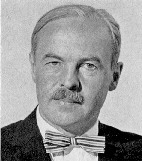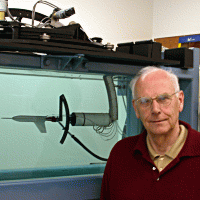A short history of our institute
|
Richard Knoller designed the old wind tunnel. |
In 1909, the institute was founded as a Chair for Airshipping and Automotive Engineering (Lehrkanzel für Luftschiffahrt und Automobilwesen). The first head of the institute was Richard Knoller (* Apr 25, 1869, † Mar 4, 1926). He worked from Nov 30, 1909 to Mar 4, 1926 on drag and friction in liquids, the theory of propellors, and the stability of hang gliders.
In 1912 a new laboratory became available. It was essentially housing the wind tunnel which was built from 1911 to 1914. The Eiffel-type wind tunnel had an open test section with the airstream being directed from the center top towards the base of the building. The return flow was guided through the four corners of the building and propelled by four engines placed at the entrance of each return-flow channel in the basement. Each of them provided a power of 7.5 hp which enabled a maximum velocity of 90 km/h in the test section with a cross sectional area of 2.4m^2;. The particular construction of the wind tunnel allowed an easy access from all sides to the models mounted in the test section.
|
|
||
The institute building in 1911, housing the wind tunnel. Today it has been refurnished into a modern bar (Nelson's) in the yard of the TU main building. |
|
Investigation of an airfoil in the open test section of the wind tunnel. The basic structure consisting of the nozzle (top) and mouth (bottom) can still be seen in original at the heart of Nelson's bar. |
|
After the death of Richard Knoller, Richard Katzmayr (* Nov 3, 1884, † Apr 12, 1945) held the deputy chair from 1926 to 1937. His interest and work were devoted to wing measurements, suction of boundary layers, and the flow through railroad tunnels. In 1928 the Chair for Airshipping and Automotive Engineering split into a Chair for Automotive Engineering and a Laboratory for Aeromechanics and Airshipping. The laboratory was headed by Leo Kirste (* Mar 8, 1892) from 1937 to Mar 1938.
Independent of the Laboratory for Aeromechanics and Airshipping a chair for Fluid Mechanics was founded in 1941. The position was held by by Oskar Tietjens until 1945. He was assisted, from 1943 to 1945, by Oskar Schrenk who was teaching flight mechanics.
|
Klaus Oswatitsch |
In 1945 the chair for Fluid Mechanics and the Laboratory for Aerodynamics and Airshipping, which has been vacant since 1938, merged into the Institute for Fluid Mechanics. From Jan 1, 1946 to Sep 4, 1958 Franz Magyar (* May 6, 1894, † Sep 4, 1958) held the chair of the institute. He refurnished the power supply of the wind tunnel from DC to three-phase current. Scientifically he worked on steam turbines, ventilators, velocity measurements of air flows, and spraying through rotary nozzles. Another subject was the theoretical treatment of Eiffel cyclones. After Franz Magyar passed away, Rudolf Bruniak became deputy chair from Sep 5, 1958 to Mar 28, 1960.
In more recent times, from Mar 29, 1960 to 1980, Klaus Oswatitsch (* Mar 10, 1910, † Aug 1, 1993) held the Chair of Fluid Mechanics. His work on super- and hypersonic flows, condensation effects, and the dynamics of gases in general have received international attention. In particular, his comprehensive monographs on Gas Dynamics, namely Gasdynamik (1952), Grundlagen der Gasdynamik (1976), and Spezialgebiete der Gasdynamik (1977), became famous and served as the standard textbooks for generations of fluid dynamicists. His way of science and his personality have left a deep and lasting influence on his pupils and successors.
|
Max F. Platzer |
Klaus Oswatitsch was succeeded by Maximilian F. Platzer in Mar 1982. In 1984 Max Platzer moved to the Naval Postgraduate School in Monterey, CA, where he became Department Chair of Aero- and Astronautics. Currently, he is still active there as a professor emeritus.
In 1973, the Institute of Gas Dynamics and Thermodynamics was founded at the initiative of Klaus Oswatitsch and former rector Fritz Paschke. Wilhelm Schneider was appointed Professor of Gas Dynamics and Thermodynamics, acting as head of the institute until 1979, when the institute merged with the Institute of Fluid Mechanics to form the Institute of Fluid Mechanics and Heat Transfer. The latter was alternately headed by Wilhelm Schneider (emeritus professor since Oct 1, 2006), Alfred Kluwick (emeritus professor since Oct 1, 2010), and Helmut Sockel (emeritus professor since Oct 1, 2003). They have carried on the heritage of Klaus Oswatitsch and made significant contributions to boundary layer theory, nonlinear waves and transsonic flows (Alfred Kluwick), turbulence, convective heat transfer, multiphase flows and flows with phase change (Wilhelm Schneider), and experimental tunnel and building aerodynamics (Helmut Sockel). Hendrik C. Kuhlmann was appointed Professor for Numerical Fluid Mechanics from Oct 1, 2003. Since Oct 1, 2010 he is acting as the head of the Institute.
The historically interested reader is referred to the following supplemental information
The institute's genealogy Genealogy
Paper of Prof. em. H. Sockel soon to come
Presentation of Prof. em. W. Schneider on the occasion of the institute's 100th anniversary on Nov 30, 2009 covering the years from 1960 to 2009 Slides

